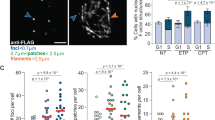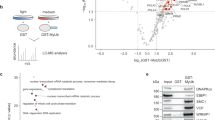Abstract
To determine the role of actin–ribonucleoprotein complexes in transcription, we set out to identify novel actin-binding proteins associated with RNA polymerase II (Pol II). Using affinity chromatography on fractionated HeLa cells, we found that hnRNP U binds actin through a short amino acid sequence in its C-terminal domain. Post-transcriptional gene silencing of hnRNP U and nuclear microinjections of a short peptide encompassing the hnRNP U actin-binding sequence inhibited BrUTP incorporation in vivo. In living cells, we found that both actin and hnRNP U are associated with the phosphorylated C-terminal domain of Pol II, and antibodies to actin and hnRNP U blocked Pol II–mediated transcription. Taken together, our results indicate that a general actin-based mechanism is implicated in the transcription of most Pol II genes. Actin in complex with hnRNP U may carry out its regulatory role during the initial phases of transcription activation.
This is a preview of subscription content, access via your institution
Access options
Subscribe to this journal
Receive 12 print issues and online access
$189.00 per year
only $15.75 per issue
Buy this article
- Purchase on Springer Link
- Instant access to full article PDF
Prices may be subject to local taxes which are calculated during checkout





Similar content being viewed by others
References
Orphanides, G. & Reinberg, D. A unified theory of gene expression. Cell 108, 439–451 (2002).
Hahn, S. Structure and mechanism of the RNA polymerase II machinery. Nat. Struct. Mol. Biol. 11, 394–403 (2004).
Sims III, R.J., Mandal, S.S. & Reinberg, D. Recent highlights of RNA-polymerase-II-mediated transcription. Curr. Opin. Cell Biol. 16, 263–271 (2004).
Green, M.R. TBP-associated factors (TAFIIs): multiple, selective transcriptional mediators in common complexes. Trends Biochem. Sci. 25, 59–63 (2000).
O'Brien, T., Hardin, S., Greenleaf, A. & Lis, J.T. Phosphorylation of RNA polymerase II C-terminal domain and transcriptional elongation. Nature 370, 75–77 (1994).
Lu, H., Zawel, L., Fisher, L., Egly, J.M. & Reinberg, D. Human general transcription factor IIH phosphorylates the C-terminal domain of RNA polymerase II. Nature 358, 641–645 (1992).
Marshall, N.F., Peng, J., Xie, Z. & Price, D.H. Control of RNA polymerase II elongation potential by a novel carboxyl-terminal domain kinase. J. Biol. Chem. 271, 27176–27183 (1996).
Orphanides, G. & Reinberg, D. RNA polymerase II elongation through chromatin. Nature 407, 471–475 (2000).
Komarnitsky, P., Cho, E.J. & Buratowski, S. Different phosphorylated forms of RNA polymerase II and associated mRNA processing factors during transcription. Genes Dev. 14, 2452–2460 (2000).
Shilatifard, A., Conaway, R.C. & Conaway, J.W. The RNA polymerase II elongation complex. Annu. Rev. Biochem. 72, 693–715 (2003).
Arndt, K.M. & Kane, C.M. Running with RNA polymerase: eukaryotic transcript elongation. Trends Genet. 19, 543–550 (2003).
Hager, G.L, Nagaich, A.K., Johnson, T.A., Walker, D.A. & John, S. Dynamics of nuclear receptor movement and transcription. Biochim. Biophys. Acta 1677, 46–51 (2004).
Bentley, D. The mRNA assembly line: transcription and processing machines in the same factory. Curr. Opin. Cell Biol. 14, 336–342 (2002).
Proudfoot, N.J., Furger, A. & Dye, M.J. Integrating mRNA processing with transcription. Cell 108, 501–512 (2002).
Carty, S.M. & Greenleaf, A. Hyperphosphorylated C-terminal repeat domain-associating proteins in the nuclear proteome link transcription to DNA/chromatin modification and RNA processing. Mol. Cell Proteomics 8, 598–610 (2002).
Shav-Tal, Y. & Zipori, D. PSF and p54nrb/NonO—multifunctional nuclear proteins. FEBS Lett. 531, 109–114 (2002).
Emili, A. et al. Splicing and transcription-associated proteins PSF and p54nrb/NonO bind to the RNA polymerase II CTD. RNA 8, 1102–1111 (2002).
Dreyfuss, G., Kim, V.N. & Kataoka, N. Messenger-RNA-binding proteins and the messages they carry. Nat. Rev. Mol. Cell Biol. 3, 195–205 (2002).
Kiledjian, M. & Dreyfuss, G. Primary structure and binding activity of the hnRNP U protein: binding RNA through RGG box. EMBO J. 11, 2655–2664 (1992).
Martens, J.H.A., Verlaan, M., Kalkhoven, E., Dorsman, J.C. & Zantema, A. scaffold/matrix attachment region elements interact with a p300-scaffold attachment factor A complex and are bound by acetylated nucleosomes. Mol. Cell. Biol. 22, 2598–2606 (2002).
Romig, H., Fackelmayer, F.O., Renz, A., Ramsperger, U. & Richter, A. Characterization of SAF-A, a novel nuclear DNA-binding protein from HeLa cells with high affinity for nuclear matrix/scaffold attachment DNA elements. EMBO J. 11, 3431–3440 (1992).
Fackelmayer, F.O., Dahm, K., Renz, A., Ramsperger, U. & Richter, A. Nucleic-acid-binding properties of hnRNP U/SAF-A, a nuclear matrix protein which binds DNA and RNA in vivo and in vitro. Eur. J. Biochem. 221, 749–757 (1994).
Olave, I.A., Reck-Peterson, S.L. & Crabtree, G. Nuclear actin and actin-related proteins in chromatin remodelling. Annu. Rev. Biochem. 71, 755–781 (2002).
Bettinger, B.T., Gilbert, D.M. & Amberg, D.C. Actin up in the nucleus. Nat. Rev. Mol. Cell Biol. 5, 410–415 (2004).
Percipalle, P. et al. Actin bound to the heterogeneous nuclear ribonucleoprotein hrp36 is associated with Balbiani ring mRNA from the gene to polysomes. J. Cell Biol. 153, 229–235 (2001).
Percipalle, P. et al. Nuclear actin is associated with a specific subset of hnRNP A/B-type proteins. Nucleic Acids Res. 30, 1725–1734 (2002).
Scheer, U., Hinssen, H., Franke, W.W. & Jockusch, B.M. Microinjections of actin antibodies demonstrates involvement of nuclear actin in transcription of lampbrush chromosomes. Cell 39, 111–122 (1984).
Egly, J.M., Miyamoto, N.G., Moncollin, V. & Chambon, P. Is actin a transcription initiation factor for RNA polymerase B? EMBO J. 3, 2363–2371 (1984).
Zhu, X., Zeng, X., Huang, B. & Hao, S. Actin is closely associated with RNA polymerase II and involved in activation of gene transcription. Biochem. Biophys. Res. Commun. 321, 623–630 (2004).
Percipalle, P. et al. An actin-ribonucleoprotein interaction is involved in transcription by RNA polymerase II. Proc. Natl. Acad. Sci. USA 100, 6475–6480 (2003).
Kim, M.K. & Nikodem, V.M. hnRNP U inhibits carboxy-terminal domain phosphorylation by TFIIH and represses RNA polymerase II elongation. Mol. Cell. Biol. 19, 6833–6844 (1999).
Elbashir, S.M. et al. Duplexes of 21-nucleotide RNAs mediate RNA interference in cultured mammalian cells. Nature 411, 494–498 (2001).
Palacios, I.M., Gatfield, D., St Johnston, D. & Izaurralde, E. An eIF4AIII-containing complex required for mRNA localization and nonsense-mediated mRNA decay. Nature 427, 753–757 (2004).
Maldonado, E. et al. A human RNA polymerase II complex associated with SRB and DNA-repair proteins. Nature 381, 86–89 (1996).
Mortillaro, M.J. & Berezney, R. Matrin CYP, an SR-rich cyclophilin that associates with the nuclear matrix and splicing factors. J. Biol. Chem. 273, 8183–8192 (1998).
Otero, G. et al. Elongator, a multisubunit component of a novel RNA polymerase II holoenzyme for transcriptional elongation. Mol. Cell 3, 109–118 (1999).
Wada, T. et al. FACT relieves DSIF/NELF-mediated inhibition of transcriptional elongation and reveals functional differences between P-TEFb and TFIIH. Mol. Cell 5, 1067–1072 (2000).
Pederson, T. & Aebi, U. Actin in the nucleus: what form and what for? J. Struct. Biol. 140, 3–9 (2003).
Andrin, C. & Hendzel, M.J. F-actin dependent insolubility of chromatin modifying components. J. Biol. Chem. 279, 25017–25023 (2004).
Zhao, K. et al. Rapid and phosphoinositol-dependent binding of the SWI/SNF-like BAF complex to chromatin after T lymphocyte receptor signalling. Cell 95, 625–636 (1998).
Mattern, K.A., van Goetherm, R.E., de Jong, L. & van Driel, R. Major internal nuclear matrix proteins are common to different human cell types. J. Cell. Biochem. 65, 42–52 (1997).
Mortillaro, M.J. et al. A hyperphosphorylated form of the large subunit of RNA polymerase II is associated with splicing complexes and the nuclear matrix. Proc. Natl. Acad. Sci. USA 93, 8253–8257 (1996).
Jonsson, A.P. et al. Recovery of gel-separated proteins for in-solution digestion and mass spectrometry. Anal. Chem. 73, 5370–5377 (2001).
Fomproix, N. & Percipalle, P. An actin–myosin complex on actively transcribing genes. Exp. Cell Res. 294, 140–148 (2004).
Haukenes, G., Szilvay, A.M., Brokstad, K.A., Kanestrom, A. & Kalland, K.H. Labeling of RNA transcripts of eukaryotic cells in culture with BrUTP using a liposome transfection reagent (DOTAP). Biotechniques 22, 308–312 (1997).
Acknowledgements
We thank B. Daneholt, N. Visa and D. Nashchekin for critically reading this manuscript. This work was supported by grants from the Swedish Research Council, the Swedish Cancer Society (project 4159), the Lars Hiertas Minne Foundation and the Jeansson Foundation to P.P. A.K. is a recipient of a doctoral fellowship from the Swedish Institute.
Author information
Authors and Affiliations
Corresponding author
Ethics declarations
Competing interests
The authors declare no competing financial interests.
Supplementary information
Supplementary Fig. 1
Post-transcriptional gene silencing of hnRNP U by RNAi. (PDF 223 kb)
Rights and permissions
About this article
Cite this article
Kukalev, A., Nord, Y., Palmberg, C. et al. Actin and hnRNP U cooperate for productive transcription by RNA polymerase II. Nat Struct Mol Biol 12, 238–244 (2005). https://doi.org/10.1038/nsmb904
Received:
Accepted:
Published:
Issue Date:
DOI: https://doi.org/10.1038/nsmb904
This article is cited by
-
JUN-induced super-enhancer RNA forms R-loop to promote nasopharyngeal carcinoma metastasis
Cell Death & Disease (2023)
-
Myosin VI regulates the spatial organisation of mammalian transcription initiation
Nature Communications (2022)
-
SAF-A mutants disrupt chromatin structure through dominant negative effects on RNAs associated with chromatin
Mammalian Genome (2022)
-
Purification and partial characterization of vinculin from chicken liver nuclear extract
Biologia (2021)
-
Analysis of a structured intronic region of the LMP2 pre-mRNA from EBV reveals associations with human regulatory proteins and nuclear actin
BMC Research Notes (2019)



